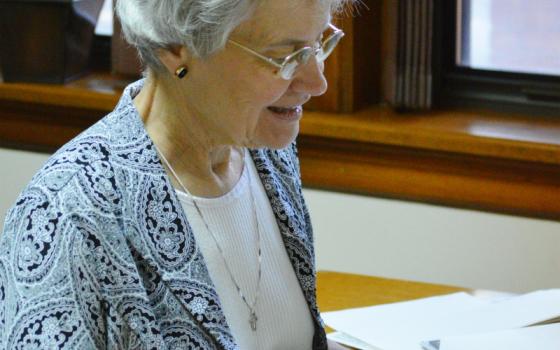When Sr. Sally Witt of the Sisters of St. Joseph of Baden, Pennsylvania, opted to study history, she wasn't sure what she'd do with her degree. But the historian has since found her niche in writing the official histories of congregations of women religious. In 2005, she published the history of the Sisters of St. Joseph of Watertown, New York, and in 2014, she published the history of the Sisters of the Holy Spirit.
Witt is in the process of updating the history of the Sisters of St. Joseph of Concordia, Kansas — their last history, Footprints on the Frontier, was published in 1948. Witt talked to Global Sisters Report from Concordia, where she was conducting research for her book.
GSR: You've said it takes about seven years for you to complete a history. What is the process that takes place in those seven years?
Witt: What I need to do, always, is go through the official records of the community. In their archives, they save all of the letters written by a superior or president to all the sisters. They have kept for all of their existence minutes of their council meetings, or whatever they call that body. There's a lot of really good material, primary sources.
However, the story is not just a story of the people in the leadership positions in communities. It's the story of the community as such. And so, I talk to members of the community, do some oral history interviews, some conversations. And a lot of listening. If people mention something several times, I know that's important.
I came here to Concordia, and very often — even now — people will talk about the closing of Marymount College [in 1989]. It opened in 1922, and it was a great pride of that community. It gave an education to women — it was a women's college at first — and people who had never even thought of college went to Marymount College. And I know that's very important. I know that lives in their hearts, and so that's a really important thing to follow.
But even that isn't enough. I have to get a lot of sources for context. What was happening in religious life? How does what was happening in one community compare with what was going on generally? I look to the writings of other historians who have done this. And then I need to look at what was happening in life in general.
One book that's been very helpful to me is Anne Butler's Across God's Frontiers. She talked about sisters who went to the West and what it meant when they got away from their motherhouses: They got away from the structure of every day, and they couldn't replicate it in the West, and how that changed them and how they adapted to the West. Sisters adapt to whatever place we're part of.
What's the most challenging part of writing a congregational history?
I don't know what's been the most challenging, but I'll say this: Much of what has been written is what sisters have written, and most of the writing now is not being done by sisters. But what sisters have written has been almost a hagiography, so it's not really the true story.
The people who belong to the Conference on the History of Women Religious, at this point, are mostly not members of religious communities. They are historians. They are good historians. They are well-trained. Many of them are young and beginning their careers in history. They are really doing good work and are going to do good work. In fact, that's part of what I see in the future of religious life: There will be people doing very good work on the history of religious life. But there are only a few of us who are in this wonderful, privileged position of being able to say, "OK, we are looking at this as historians. We are also looking at this as insiders." How do I tell the story of religious life as one who has lived it?
It's so easy to misunderstand even little things. Sisters use a lot of internal words, and they don't always mean the same to us as they mean to other people. As an example, a sister who had been in our community more than 10 years was doing some transcribing for me — these were letters from the 1930s. We had sisters in China, and they were writing home. One sister wrote to her blood sister and thanked her for a poem, which she had sent, and said, "I put it on the wall above our bed."
This sister, the one who was transcribing, turned to me and said, "They shared beds in China." What she didn't know was that, even as recently as the 1960s, we used "our" to refer to everything. We never said anything was "mine." It had to be "ours." Now, we no longer do that, but a word like that could give an impression that simply is not true.
Is there a push to get more sisters interested in history as an academic field?
I don't see that, if there is. What I see is this: We really don't educate our sisters in the same way we used to. There would be this sense that you needed somebody in this field, so we'd ask this person to go into it and get a degree. We don't do that in the same way. People come educated, and I don't see as many people coming who are interested in humanities. So I don't see that happening.
I wasn't at the very early meetings of the Conference on the History of Women Religious, but people tell me it was just about all sisters. And then, each time, it was fewer and fewer sisters, more and more people who aren't in religious life. And now, the sisters are a minority in that group, which I think is fine. I think it's really very good. But it gives a picture of how this is going.
What do you wish people knew about the history of women religious?
We have a tendency to talk about renewal and to say, "This is renewal. It happened, and that's it," when renewal happened over a long period of time. Each community did it in its own time, and 1970 was not at all like 1980 or 1990 or the 2000s. We have had various stages of religious life and tremendous changes all through that period.
I also wish that they knew about the origins because they are quite surprising. It's amazing that in the last 50 years of the 1800s, there are lots of communications among sisters from different cities. How they did that and how they traveled is quite amazing. At the beginning of the 1900s, we just became separate from one another. Now, we're certainly not that way anymore, but it's good to know that that sharing existed before on a very large basis.
Why is understanding the history of women religious important?
You can't tell the story of U.S. society — and I'm saying U.S. because that's where I'm involved, but I think the same would be true throughout the world — but you cannot tell the story, you can't even understand it, without knowing about women religious. It's part of the story of education. It's part of the story, certainly, of health care as it's developed in this country. It's obviously part of the story of women. Some historians who are in the field of history of women religious have gotten there because they started out with the history of women.
[Dawn Araujo-Hawkins is a Global Sisters Report staff writer. Her email address is [email protected]. Follow her on Twitter: @dawn_cherie.]

